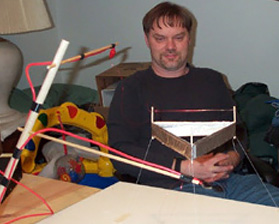
Finally, there has been progress made on the electrogravitic ‘lifters’ front, at least in a fashion. For years I was experimenting with what is properly referred to here as electroaerodynamic thrust, which I used to fly these tiny, foil and balsa electric kites. While available power supplies frustratingly limited my own efforts to these smaller, tabletop projects, restrained only by tape, thread and fine wire, I always appreciated the true potential of this revolutionary propulsion technology.
For the longest time, electrogravitic hobbyists like myself attempted to construct lighter, and more efficient power supplies, to allow their designs the ability to float, and fly around freely. It would seem that recently, a group of researchers at MIT succeeded in building an amazingly robust, light weight power supply, small enough to fit into a conventional model air frame. The driving force of this Ion Wind Drive is a on-board 40kv battery power supply, which provides enough trust to propel an aircraft with a 5 meter wide wingspan, flying approximately 60 meters across an enclosed sports hall.
Unlike those ion drives successfully used in space satellites for decades, again without any moving parts, the MIT team achieved steady-level flight, while this craft repeatedly pushed itself along using only the surrounding air as the accelerant. Truly an incredible technological achievement, scaling all that heavy electronics down into a lightweight air frame, showing how this silent and clean form of propulsion may yet be made practical.
Although limited by my own abilities and resources, I can see the day in the future when someone develops full size aircraft, capable of carrying not just it’s own power supply, but human passengers as well. Perhaps the day of purely electric flight is now much closer than I previously imagined. Let us hope so!





